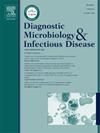Evaluation of the QIAstat-Dx® Gastrointestinal Panel 2 for detection of viral, bacterial and parasitic pathogens in fecal swab specimens
IF 1.8
4区 医学
Q3 INFECTIOUS DISEASES
Diagnostic microbiology and infectious disease
Pub Date : 2025-09-26
DOI:10.1016/j.diagmicrobio.2025.117129
引用次数: 0
Abstract
This study evaluates the performance of the QIAstat-Dx® gastrointestinal panel 2 (GIP2) (Qiagen, Spain) for the gastrointestinal pathogens from Fecalswab® specimens (Copan, Italy). For most targets, specimens were tested initially on the AllplexTM GI assays (Seegene, South Korea). For P. shigelloides, specimens were initially tested on BIOFIRE® GI Panel (BGIP) (bioMérieux, France). Two hundred fifty-nine specimens were tested on the GIP2 (69.5 % archived, 30.5 % prospective). Specimens with discordant results on AllplexTM GI assays were tested on BGIP or Xpert® Norovirus (Cepheid, USA), while discordant results for P. shigelloides were tested by culture. Consensus results were obtained based on agreement of at least 2 of 3 tests. The percent positive and negative agreement (PPA, PNA) were calculated on a per target basis. Compared to consensus, GIP2 PPA was 95.02 % (95 % CI 91.78 – 97.25 %) and PNA was 99.98 % (95 % CI 99.90- 100.00 %). GIP2 performed well for bacterial and parasitic targets with PPA and PNA >97 %, however had a PPA of 88.3 % (95 % CI 80-81 – 93.61 %) and PNA of 100.0 % (95 % CI 99.75 – 100.00 %) for viral targets. When CT values were examined, QIAstat-dx GIP2 produce similar values to the AllplexTM GI-viral assay. However, bacterial and parasitic targets on QIAstat-dx GIP2 trends towards lower CT values when compared to the AllplexTM GI assays.
QIAstat-Dx®胃肠道检测试剂盒2用于检测粪便拭子标本中的病毒、细菌和寄生虫病原体的评估
本研究评估了QIAstat-Dx®胃肠道面板2 (GIP2)(西班牙Qiagen公司)对Fecalswab®标本(意大利Copan公司)胃肠道病原体的检测性能。对于大多数靶点,标本最初采用AllplexTM GI测定法(Seegene,韩国)进行检测。对于志贺氏杆菌,标本最初在BIOFIRE®GI Panel (BGIP) (biomsamrieux, France)上进行检测。在GIP2上测试了259个标本(69.5%存档,30.5%预期)。AllplexTM GI检测结果不一致的标本用BGIP或Xpert®诺如病毒(造父变星,美国)进行检测,而志贺杆菌检测结果不一致的标本用培养法进行检测。一致的结果是基于3个测试中至少2个的一致。积极和消极协议的百分比(PPA, PNA)是按每个目标计算的。与共识相比,GIP2 PPA为95.02% (95% CI 91.78 ~ 97.25%), PNA为99.98% (95% CI 99.90 ~ 100.00%)。GIP2对细菌和寄生虫靶标表现良好,PPA和PNA为97%,但对病毒靶标PPA为88.3% (95% CI 80-81 - 93.61%), PNA为100.0% (95% CI 99.75 - 100.00%)。当检查CT值时,QIAstat-dx GIP2产生与AllplexTM gi病毒检测相似的值。然而,与AllplexTM GI检测相比,QIAstat-dx GIP2上的细菌和寄生虫靶标的CT值更低。
本文章由计算机程序翻译,如有差异,请以英文原文为准。
求助全文
约1分钟内获得全文
求助全文
来源期刊
CiteScore
5.30
自引率
3.40%
发文量
149
审稿时长
56 days
期刊介绍:
Diagnostic Microbiology and Infectious Disease keeps you informed of the latest developments in clinical microbiology and the diagnosis and treatment of infectious diseases. Packed with rigorously peer-reviewed articles and studies in bacteriology, immunology, immunoserology, infectious diseases, mycology, parasitology, and virology, the journal examines new procedures, unusual cases, controversial issues, and important new literature. Diagnostic Microbiology and Infectious Disease distinguished independent editorial board, consisting of experts from many medical specialties, ensures you extensive and authoritative coverage.

 求助内容:
求助内容: 应助结果提醒方式:
应助结果提醒方式:


